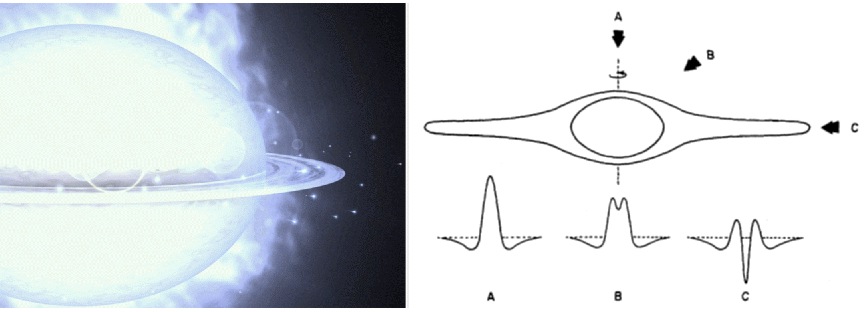Much of my research has involved the ways that the outflows from hot stars can be modified by various departures from "classical" spherical symmetry. For example, rapid rotation distorts stars to become oblate (i.e., bulged out at the equator), and in some cases this causes the emitted radiation to be re-distributed over the distorted surface. This effect, known as gravity darkening, causes the polar regions to be brighter and the equatorial regions to be dimmer:

For almost a quarter of a century, I've been fascinated by a particular sub-class of hot stars: the classical Be Stars. These are rapidly rotating stars that appear to be surrounded by dense disks of gas around their equators. However, in nearly all cases these are not "accretion disks," but the opposite: decretion disks (sometimes unfortunately called "excretion disks"); i.e., a gradual ejection of gas from the equators of the stars. Centrifugal forces, due to rapid rotation, may help combat the inward pull of gravity and help eject this gas. However, many Be stars are not rotating fast enough for gravity to be completely cancelled out -- and thus the source of mass and angular momentum in the disks is still unknown.

Thus, a lot of my research has focused on how rapid rotation can help (or hinder) the outflow of gas from hot stars in various ways...
-
Centrifugal and Coriolis forces can deflect wind streamlines
toward the equator, enhancing the density and possibly forming a shocked
wind compressed disk (WCD) in the equatorial plane.
This was suggested originally as a possible explanation for the
classical Be stars, but it may be the case that gravity darkening
disrupts this equatorial focusing.
After all, the winds from these stars are radiation driven, and
if the radiation field is deflected "pole-wards" (away from the
equatorial plane), then the flow of gas should be, too.
-
The wind can enhance non-axisymmetric perturbations in the photosphere
and create co-rotating structures in the circumstellar flow.
Such corotating interaction regions (CIRs) are known
to form an important component of the solar wind, and their existence
has been proposed in hot stars to possibly explain the observed
"discrete absorption components" (DACs) in ultraviolet P Cygni line spectra.
Cranmer
& Owocki (1996)
performed some of the first simulations of how CIRs can give rise to DACs.
- Much of the above work was a part of my 1996 PhD Thesis. Since then, I've been thinking more about how we use rotationally broadened spectral lines to determine the true rotation rates of the Be stars (Cranmer 2005) and how stellar pulsations might be able to feed angular momentum into the upper atmospheres of Be stars and produce their elusive decretion disks (Cranmer 2009).